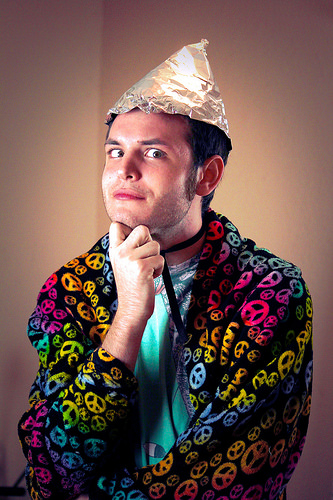Being a huge nonsense or not, the truth is that conspiracy “theories” gathered many followers all around the world, reason of why it could be useful knowing the possible reasons behind their appeal.

(Read the second part of this article here)
Why do we believe in conspiracies?
The main problem here lies not in the fact that there might be people around who might make up such stories, but in that there is a large and varied audience believing them. In their book American Conspiracy Theories, scientists Joseph Uscinski, and Joseph Parent showed, in fact, how conspiracy “theories” permeate all sectors within society without really having to do with factors such as cultural level, religion, ideology or age. Once here, the question naturally arises of why all these fables, despite their obvious lack of logic, exert such a remarkable attraction over the minds of countless people. The explanation is both incidental and related to physiology and how human mind´s works.
Starting with the second type of reasoning, one of the first and main causes is perhaps that all these “theories” respond to a very natural human impulse, that of putting order within the cosmos. According to professor Jan-Willem van Prooijen, of the VU University Amsterdam, and focused for years on conspiracy “theories”, it is a universal human trait to relate and link different elements that do not really have any relationship between them in situations of loss of control. Thus, and when facing quite confusing situations, these conspiracy “theories” happen to offer a sort of explanation, maybe quite tortuous but also somehow simple in their own way, and even with some internal logic. By doing this, they reduce complex social phenomena to a series of actions made by so-called secret agents and individuals, very often raising the question of cui bono (who benefits) while ignoring that, in real life, nothing is is that easy to determine.
Another favourable factor is the ease with which human mind falls into different cognitive biases, and their preponderance when making daily decisions, usually putting intuition, emotions and social relationships above logic and rationality. It has been fully studied how human brain tends to act in a more transcendental than empiricist way, i.e. to identify patterns and agents even when there are not or when they are just mere coincidences, and also failing to realize that sometimes real life is too complex to be so easily explained. This mindset is very useful for the most basic survival skills (since it quickly identifies potential threats) but is also responsible for superstition and magical thinking.

(The famous phrase “I want to believe” shows not only a belief but also the will to trust against any evidence. Source: MrGyro.co.uk Flickr via Compfight cc)
Among those different cognitive bias which tends to affect human mind these “theories” often suffer from “confirmation bias” and “hindsight bias”, both based on starting from an already-made conclusion and selectively looking only at those evidences that can support it, which is very characteristic of pseudoscience and frontally opposed to scientific empiricism, where the final conclusion is reached only at the end of every research. In the first case, it is the tendency to see evidence supporting only the theory itself and not the opposite, and in the second case, to retrospectively changing the perception of form-past events, in order to make them coincide with previously adopted conclusions. Both mental mechanisms have been widely studied, as evidenced, for example, by professors Andre Spicer and Mats Alvesson in their book The Stupidity Paradox, where they explain that “once we have taken decisions, which often occurs in milliseconds, we began the laborious process to prove that we are right, and when the facts do not match with our beliefs, we prefer to change the facts, not our beliefs”. Talking more specifically about conspiracy fables, Rob Brotherton, academic, psychologist and author of Suspicious Minds: Why We Believe Conspiracy Theories, says “once someone believes in a conspiracy theory, dissuading him or her of it is an uphill battle. That’s because belief in a conspiracy is not based on facts and logic. The lack of evidence only serves to reinforce the idea of that evidence having been purposely hidden.” Michael J. Wood, Karen M. Douglas and Robbie M. Sutton, in their aforementioned Dead and Alive: Beliefs in Contradictory Conspiracy, also added that these stories “conspiracy beliefs, even when wrong, are notoriously resistant to falsification, with new layers of conspiracy being added to rationalize each new piece of disconfirming evidence.”
Another favourable element is the fact that, due to their particular internal logic, once one of these fables is believed, it is very easy to believe in others, as it is also very easy for them to grow on their own as time passes by. On this issue, Michael J. Wood, Karen M. Douglas and Robbie M. Sutton showed in their study that it is even possible to believe in conspiracy “theories” that actually contradict each other. About this, they indicated “one massive, sinister conspiracy could be successfully executed in near-perfect secrecy suggests that many such plots are possible. Over time, the view of the world as a place ruled by conspiracies can lead to conspiracy becoming the default explanation for any given event—a unitary, closed-off world-view in which beliefs come together in a mutually supportive network known as a monological belief system.” All this offers an amazing ability for those fables to grow, as seen by Arthur Goldwag in his book Cults, Conspiracies, and Secret Societies, where he says “when something important happens (or something is believed as important), whatever leads to that event also seems to be highly relevant.”
(Cass Sunstein describes how conspiracy theories work and how they explain the current disagreements between political parties)
In the right place, at right time
While human mind can unintentionally play in their favour, it is also very important that all these “theories” benefit from one of the most typical issues of our times: the identity crisis of contemporary citizenry, his lack of confidence in agencies and institutions which, traditionally, were lined with authority (such as church, crown, state, political parties, family…), and the absence of new agents who had similar powers or roles. If we bear in mind also that there is some distrust and suspicion among common people, sometimes unjustifiably and sometimes not, regarding some entities or institutions that are often perceived as powerful or opaque (as it may be the case of national governments or the various supranational entities that have emerged over the last decades) as well as a great ignorance regarding scholars and science, we have a perfect breeding ground for suspicion. And so, once certain people have a negative reception among common citizens, whatever comes out of them will also be seen with suspicion, as confirmed by Heider´s balance theory (1958), who stated “perception of an object or social actor is affected by its relationship with other actors and those existing opinions that could exist about it.”

(Even if it does not seem so, conspiracy “theories” do permeate wide ranks within society, and are not exclusive of crazy losers, as it has often been argued. Source: DarlingJack Flickr via Compfight cc)
In addition it should also be considered that all these stories prove to be genuinely entertaining. Well seen, all these fables have in fact notable dramatic elements, such as a forbidden mystery, incredibly evil and powerful villains, an intricate network of lies and deception to be methodically and painstakingly solved as if it was a risky puzzle, an endangered world, the epic behind a small group of righteous people struggle against a cruel enemy…
And not only. It should be noted also how circumstantial elements can help them to raise in popularity, such as traumatic events or stressful situations (11-S), ideologies (left-wing people are often wary of large multinationals, conservatives of liberal atmosphere within the academic world) and even group identities (USA Afro-Americans tend to be more suspicious about their own government).
Finally, it is precisely the epic behind those stories the last element that could explain their apparent notoriety, since all these “theories” bring to their inspired authors or their backers something often referred as “the enlightened syndrome” or “the crusader syndrome”, this is, that those are supposed to be (as it has been said before) situations in which the truth has supposedly been revealed by a very small group of individuals who have been able not only to deride the surveillance of a great conspiracy, but also to act for the sake of the entire mankind. This being the case, it is natural that their supporters are automatically catapulted (at least in their own eyes) to the category of “heroes” or “awake people”, as opposed to the ordinary mortals who would continue, according to themselves, being cheated by the system. This situation, as it is evident, can inspire a feeling of moral superiority in them, people who most likely were already suffering from a certain complex of inferiority or envy regarding the same institutions they always try to revile (such as academic or scientific community). This complex, everything to be said, which could probably be more than justified in the majority of cases, since a flagrant lack of rigor and preparation or studies, as well as insight and intellectual inbreeding, tends to be a standard among them.
(Why Do People Believe in Conspiracy Theories? Documentary by Doc Zone)
(Read the forth part of this article here)
(Lee este artículo en español aquí)

Pingback: La nueva charlatanería del siglo XXI (parte 3) | marcosmarconius·
Pingback: The new 21st century quackery (part 2) | marcosmarconius·
Pingback: The new 21st century quackery (part 4) | marcosmarconius·